An important component when arranging a garage is the choice of flooring. Traditional concrete has many drawbacks. It quickly collects dust, absorbs dirt and cracks. Increasingly, car owners are paying attention to rubber. The material is characterized by high performance and ease of maintenance.
Pros and cons of rubber flooring

Rubber flooring has a wide range of applications: garages, warehouses, playgrounds, offices, hotels and gyms. The basis of the product is made of synthetic rubber in the form of crumb. The size of the fraction is 1.5–5 mm. Polyurethane glue is used to hold the fragments together. In some cases EPDM rubber is used as an auxiliary component. In order to give color to the material, mineral-based pigments are added.
The advantages of the product include:
- increased level of moisture impermeability;
- strength;
- lack of slipping;
- ease of installation;
- optimal sound insulation;
- resistance to mechanical influences;
- long service life (at least 15 years);
- ease of care;
- resistance to temperature drops, alkalis, acids and fuel oil.
A rubber floor in a garage is not always used, since the material is quite expensive and requires professional installation. This is the main disadvantage of the coating. The concrete base is much cheaper for the car owner.
Types of rubber floor
The material is presented in the form of a piece, rolls with a cord base and a liquid mass. Each type has its own advantages and disadvantages, as well as styling technique.
Sector floor
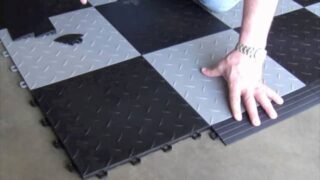
Sector view is a tile with a thickness of 0.4-4 cm. The material is resistant to abrasion, icing, dynamic shock, vibration and aggressive chemicals. It is practically not subject to damage. For flooring in a garage, this type is indispensable.
The product line is distinguished by a variety of shapes and colors. The material is available in both traditional dark tones and avant-garde acid tones. Recently, bright colors have been especially popular among consumers. Installation requires a professional approach.
Compared to the roll type, the sector rubber floor covering in the garage has a number of advantages. In case of damage, it is easy and simple to recover. Replacing the damaged segment is sufficient, while the roll material changes in a strip. No glue is required for laying modular tiles. The sections are connected by means of special fasteners.
Most of the market is modular, square, 6 cm thick. Pigment paint is added during the manufacturing process.
Rolled floor
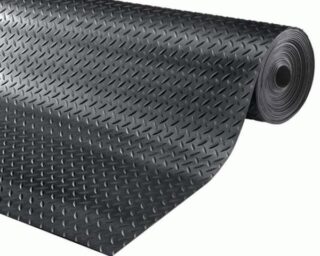
The basis of the roll type is made up of used car tires, processed in drum-type vulcanizers. High quality rubber is used for manufacturing. The coating is flexible, abrasion and chemical resistant.
The special manufacturing method ensures durability and high performance. The rubber cover in the form of rolls is easy to install and dismantle. The appearance is aesthetically pleasing.
Self-leveling coatings
The liquid mass is made up of crumb rubber, epoxy or polyurethane glue and pigment dyes. Modifiers are also added, through which certain technical indicators of the material are achieved.
Usually manufacturers produce a ready-made self-leveling rubber floor for a garage, but the components can be purchased separately and mixed according to a specific technology. The first type of product is optimal, where the components are mixed in the factory in accordance with the exact proportions.
Installation of modular tiles
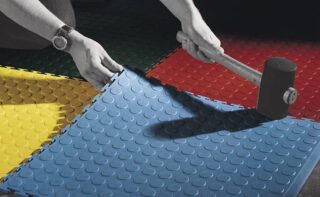
Segmental production provides certain material advantages.
The main advantages include:
- quick installation;
- ease of replacement;
- no use of glue.
Laying material:
- The material is examined for defects. The flaws are filled with a solution based on cement and sand.
- After drying, the base is subjected to a deep penetration primer. Covered two times. The first coat must dry before applying the second.
- The center of the room is indicated. The corners are connected diagonally. The garage is divided into four sections by lines perpendicular to the walls that run through the center.
- Installation is carried out from the center.
There are two types of rubber tiles. One has grooves for clamping along the edges. Adjacent segments are inserted into each other, fastened with a locking method. Such a product does not fit on an adhesive base. The modules are attached to the floor, which are laid along the edge of the floor covering, near the garage walls. The rest are in a free position, which provides strength.
The second type has no lock connection. The complexity of installation is due to the accuracy of the modules laying in relation to each other. Offset is not allowed. Even a small mistake will lead to incorrect blade laying. Therefore, the masters make a back-to-back connection. The allowable gap is 1.5 mm. During installation, a polyurethane-based adhesive is applied to the reverse side of the material.
Installation of rubber in rolls
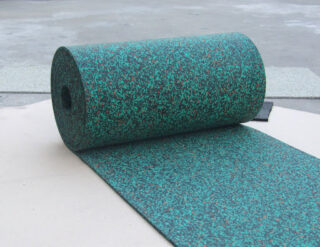
Prepare the base before laying rubber flooring in rolls. The subfloor is cleaned and primed with a special mixture including polyurethane glue with turpentine. Material consumption is 300 g per square meter. The rolls are spread on the concrete surface and left to lie down for several days. Rubber floors in a roll must be glued. The fastening process is started after all the irregularities have disappeared. The entire surface of the coating or only the joints are treated with polyurethane glue.
The lifespan of the roll floor is 10 years.
Installation of self-leveling coating
The installation of liquid rubber for the garage floor can be done manually. The finished mass is poured onto the base and leveled with a spatula or half-trowel. Self-leveling rubber floor, like other coatings of this type, requires preliminary preparation of the base. The surface is leveled, debris and dust are removed from it. The screed must not be loose and wet.
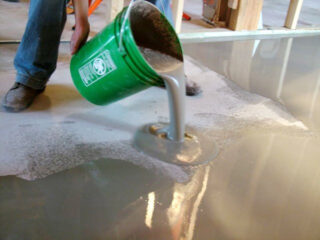
The floors are poured by hand with a small garage area. The mixture is thoroughly mixed and leveled with a special tool. The disadvantage of this type is the difficulty of maintaining the thickness.
The automatic method is also used. It involves the use of special machines, into which the ready-made rubber solution is loaded. The layer can be applied in different thicknesses without drops. The main thing is to determine its indicator. The undoubted advantage is the increased speed of the process and the high quality of the coating.
Liquid rubber can be applied by spraying. For this purpose, a special nozzle and compressor are used. The method is used to cover a large area. The process is quick, but maintaining the thickness is difficult.
Caring for the rubber floor in the garage
An important advantage of rubber flooring in a garage is ease of maintenance. The coating can withstand temperature changes. Mold does not form on it. This floor can be swept and vacuumed like a normal floor.
Greasy stains from grease, oils or grease are best removed immediately, until dirt adheres to them. For this purpose, you can use any degreasing or detergent. It is allowed to use a hard, but not a metal brush. Periodically, it is recommended to cover the rubber base with a protective layer based on acrylic. It gives it freshness. The rubber floor in the garage should be cleaned as soon as it gets dirty.









The main disadvantage: in winter, put the car in the garage and everything that sticks to the car, snow, ice and dirt melt and fall under the rubber tiles. Over time, a swamp forms there and in order to remove it it is necessary to disassemble the vaunted rubber floor. Do you need it?
It's not easier to buy old conveyor belts and just throw them on the floor